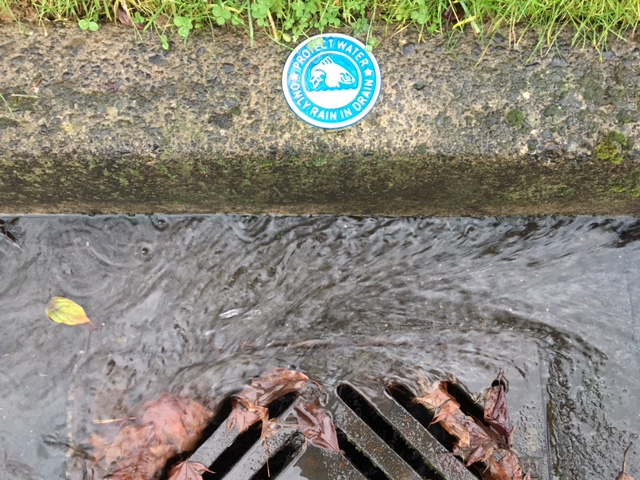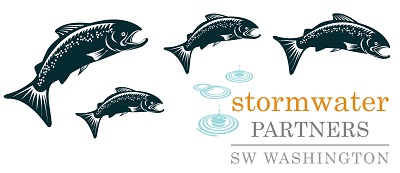Theme 1: Protecting Water in Our Community - Stormwater Superheroes!
Create a video about being Stormwater Superheroes and protecting water. This theme will have two prize categories; 1) Short – 25-40 seconds, and 2) Long – 45-60 seconds. Choose if you want to do a short or long video and dive into one of the options below:
A. Facility Connections - tell a story about a stormwater facility in your neighborhood or at your school
Stormwater facilities, sometimes called green infrastructure, are the ‘built superheroes’ of our community. These include stormwater detention ponds, treatment wetlands, bio swales, permeable pavements, drywells and bioretention (also called rain gardens). Stormwater facilities serve two main functions 1) slowing the amount of water coming off of impervious surfaces like parking lots, roads and buildings and 2) helping to trap and filter pollutants in stormwater runoff.
You probably have a stormwater facility at your school or in your neighborhood. You can find information about what type of stormwater facilities are near your school or neighborhood at Clark County Maps Online. Watch this video on how to use Clark County Maps Online to find your stormwater facility. If you don’t see your stormwater facility on the map, email us and we can help.
Here are some ideas for what you could include in your video:
- What type of stormwater facility is it?
- Does this type of stormwater facility help reduce the amount of water, filter or trap pollutants, or both?
- How does this type of stormwater facility work?
- Where does the water that goes into the stormwater facility come from?
- What pollutants might be coming from the area that feeds the stormwater facility?
- Does this type of facility have other benefits like wildlife habitat or does it help beautify the neighborhood?
- Does this facility require maintenance?
- Are there limitations to this type of facility? If so, what are they?
Tip: Learn more about stormwater facilities at: https://www.stormwaterpartners.com/facilities Watch this video for a broad overview: https://youtu.be/0x-TDvnbheM?si=Dbj-80KYbv6xPBC4
B. Simple Acts, Big Impact!
Stormwater facilities can help trap and filter some pollutants, but not all. Certain pollutants can still pass through stormwater facilities, so it is important prevent pollution upstream by practicing stream-healthy behaviors. Lights, camera, action for easy tips! Show how stream healthy actions can be fun and pollution-free. Here are a few ideas to get started, there are lots more. Let's make everyone laugh and feel the joy of making a difference!
Pet waste – Scoop it. Bag it. Trash it. Everywhere.
Always pick up after your pets. Scoop the waste, bag it, and throw it in the trash, not the compost bin. Bring extra bags when walking your dog in case someone forgot theirs. Let's keep it clean everywhere!
Car washing – Keep it Clean!
When washing cars, choose the car wash if possible because they treat the water. If not, wash it on the grass so the water can soak in and the soil can filter it. Use old towels like this to catch the wash water if you can't do it at the car wash or on the grass. There are even waterless car wash products! Let's protect our local streams and lakes!
Sweep, don’t hose!
No need for hoses! When cleaning around the house, use a broom instead of a hose. Sweeping is better because hosing sends dirty water into storm drains and waterways. Keep it clean by sweeping up and tossing the debris in the trash. Easy peasy!
Video Tips and Resources:
Tips:
- Your video is a way to teach others about the actions they can take to protect water.
- Show your message, don’t just say it.
- Use your creativity to grab viewers’ attention, keep them watching to the end and leave them with an “aha” moment.
- Consider using action, comedy and/or emotion to help get your point across.
- Stay positive – lean into hope, curiosity and solutions.
- Select a call to action and give your video a cool movie name.
Video Do’s
- Be the Bright Star: Film your own amazing video—no stock footage or photos!
- Groove with YouTube's Audio Library: Use cool music or create your own sounds. Your school district may have audio files you could use, such as Sound FX. No copyrighted music, please!
- Clean your Lens: Wipe your lens, and hold your phone steady, ideally using both hands.
- Quality is Joy: Record and edit in high quality - 24 to 30 frames per second, use 60 fps if you plan to slow down the video. Render your edited video to the highest quality as well. Under your YouTube profile, go to settings and select the highest upload quality. We want your video to shine!
- Use a FREE Video editor: If using a free video editor, select one that does not have a watermark and will export to YouTube quality (minimum resolution of 720p). Your school may have video editing software, ask your digital arts teachers about it. They may also have recommendations or you can search YouTube for advice on best free mobile phone editors for IOS or Android.
- Languages of Happiness: Create your video English or another language. Add English subtitles if your video is in another language. If your video is already in English you’re welcome to add subtitles in other languages too. Let's embrace diverse cultural perspectives.
- Fun Elements Welcome: Add humor, like educational parody, action, or drama inspired by your favorite films.
- Shoot in landscape or portrait: this year videos shot in portrait (vertical orientation) will also be accepted.
- Be safe, share accurate info, and spread the joy!
Video Don’ts
The following activities will disqualify your videos, so don’t do it…if you want to be eligible for the sweet prizes!
- Don’t use copyrighted footage, photos or music! It will disqualify your video! Check with your teachers about resources from your school.
Note: there are many sources claiming to have royalty/copyright-free music. DO NOT use them as the music copyrights can change later and disqualify your video.
- Don’t share misinformation. Information in videos must be factually accurate. Do your homework and make sure you are sharing accurate messages!
- Don’t do anything dangerous. Make sure people, animals and our environment are kept safe as you create your video. If you are demonstrating an unwanted behavior, make sure it doesn’t have the unwanted impact.
Remember: Be a positive force, be safe, and let's create videos that spread joy and love for clean water! 🌟🎬
Resources for some extra video awesomeness:
- Using a storyboard to plan your video
- How to make a storyboard for a video in 6 Steps
- 10 Mobile Videography Tips for Beginners
- Tips for street interviews
- Editing your video
- Learn more about YouTube’s Audio Library
- Adding subtitles to your video using SRT files. YouTube supports these file formats.
- Create your own music with LMMS or Audacity
- Check out these animation resources:
Check out past winners for inspiration:
Websites for more info:
- Stormwater Partners
- Clark Green Neighbors
- The River Starts Here
- Healthy home -common hazardous products
- KPTV Water Partners
Get ready to shine with positivity, young filmmakers! 🌈💧Video Tips

